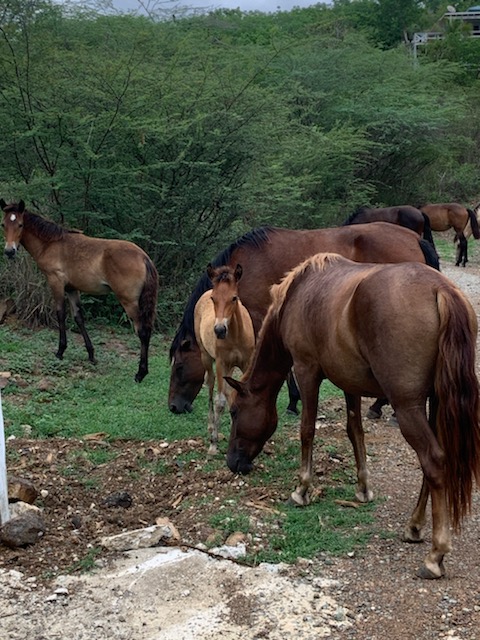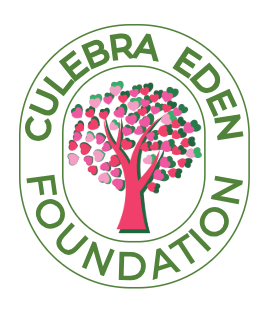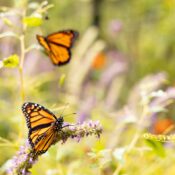
Water for the Wild
Caring for Culebra’s Free-Roaming Horses
If you’ve spent any time on the island of Culebra, you’ve likely seen them, the graceful silhouettes of horses wandering along dusty roads, grazing near the hills, or cooling off by the mangroves. They are part of the island’s charm and spirit, symbols of freedom, strength, and the untamed beauty of Culebra itself.
But behind that picturesque image lies a quiet reality: these horses often struggle to find clean, consistent sources of water. And in our tropical climate, where sun and salt mix with long dry spells, hydration isn’t just important, it’s a matter of survival.
How Much Water Does a Horse Really Need?
Horses, like humans, are mostly water. Their bodies are about 70% liquid, and every cell depends on hydration to function properly.
On average, an adult horse drinks between 5 to 15 gallons (roughly 20 to 60 liters) of water per day, more if the weather is hot, the horse is active, or they’re eating dry forage like hay.
Here’s a breakdown:
- Cool weather, light activity: around 5 gallons daily.
- Warm weather, moderate activity: 10 gallons.
- Hot, dry climate (like Culebra): 12–15 gallons — sometimes more!
When water is scarce, horses become vulnerable to dehydration, heat stress, and colic, all dangerous, sometimes fatal conditions. And while our island’s wild and semi-domesticated horses have learned to survive by wandering in search of puddles or streams, the dry season and lack of consistent rainfall can leave them with very few options.
The Ripple Effect: Why Water Matters Beyond Survival
Water isn’t just about keeping horses alive; it’s about keeping them healthy.
A hydrated horse:
- Digests food efficiently and maintains healthy gut function.
- Regulates body temperature and avoids heat exhaustion.
- Stays calmer and more alert, especially under stress.
And because these horses are part of Culebra’s natural and cultural landscape, their wellbeing directly reflects the wellbeing of our island ecosystem. When they wander farther for water, they sometimes enter roads or developed area, increasing the risk of accidents or conflict.
Our Mission: A Safe Water Station for Culebra’s Horses
At Culebra Eden Foundation, we believe that caring for our land means caring for all who call it home, humans and animals alike.
That’s why one of our upcoming goals is to create a dedicated water station at our farm: a safe, sustainable spot where the wild and unattended horses of Culebra can stop, drink, and rest.
We envision a shaded, trough-style station fed by a rainwater catchment system, clean, eco-friendly, and maintained by volunteers. A simple yet powerful gesture of compassion that says:
“You belong here too.”
Because when we share our water, we share life.
And in Culebra, every drop counts.
ESPAÑOL
Agua para los Libres: Cuidando a los Caballos de Culebra
Si has pasado algún tiempo en la isla de Culebra, seguramente los has visto: las siluetas elegantes de caballos que caminan por los caminos, pastan entre las colinas o descansan cerca de los manglares. Son parte del encanto y el espíritu de nuestra isla, símbolos de libertad, fortaleza y la belleza indómita de Culebra.
Pero detrás de esa imagen tan pintoresca existe una realidad silenciosa: muchos de estos caballos luchan por encontrar agua limpia y constante. Y en nuestro clima tropical, donde el sol y la sal se mezclan con largos períodos de sequía, la hidratación no es solo importante, es vital.
¿Cuánta Agua Necesita Realmente un Caballo?
Los caballos, al igual que nosotros, están compuestos mayormente de agua. Aproximadamente el 70% de su cuerpo es líquido, y cada célula depende de ella para funcionar correctamente.
En promedio, un caballo adulto bebe entre 5 y 15 galones (unos 20 a 60 litros) de agua por día, dependiendo del clima, su nivel de actividad y el tipo de alimento que consume.
Veamos un poco más de cerca:
- Clima fresco, poca actividad: alrededor de 5 galones diarios.
- Clima cálido, actividad moderada: unos 10 galones.
- Clima caliente y seco (como el de Culebra): 12 a 15 galones — ¡o incluso más!
Cuando el agua escasea, los caballos se vuelven vulnerables a la deshidratación, el golpe de calor y el cólico, condiciones graves que pueden ser mortales. Aunque nuestros caballos libres o semi-domesticados han aprendido a sobrevivir buscando charcas o riachuelos, durante la época seca esas fuentes muchas veces desaparecen.
El Efecto en Cadena: El Agua es Vida
El agua no solo mantiene a los caballos con vida; también les da bienestar.
Un caballo bien hidratado:
- Digiera mejor y mantiene un sistema digestivo saludable.
- Regula su temperatura corporal, evitando el agotamiento por calor.
- Se mantiene más tranquilo y alerta, incluso bajo estrés.
Y porque estos caballos forman parte del paisaje natural y cultural de Culebra, su salud refleja la salud de toda la isla. Cuando deben caminar largas distancias buscando agua, pueden llegar hasta las carreteras o zonas residenciales, aumentando el riesgo de accidentes o conflictos.
Nuestra Misión: Un Punto de Agua para los Caballos de Culebra
En Culebra Eden Foundation, creemos que cuidar la tierra también significa cuidar a todos los seres que viven en ella, humanos y animales por igual.
Por eso, uno de nuestros próximos proyectos es crear un punto de agua en nuestra finca: un espacio seguro y sostenible donde los caballos libres o desatendidos de Culebra puedan detenerse, beber y descansar.
Imaginamos un bebedero bajo sombra, alimentado por un sistema de captación de lluvia, limpio, ecológico y mantenido por voluntarios. Un gesto sencillo pero poderoso que dice:
“Tú también perteneces aquí.”
Porque cuando compartimos el agua, compartimos la vida.
Y en Culebra, cada gota cuenta.
Recent Posts
All Categories
Culebra Eden is Taking Flight
Water for the Wild
The Healing Power of Farming
Your Tribe is Calling!
+1 (787) 952-3013
Hello@CulebraEden.org




